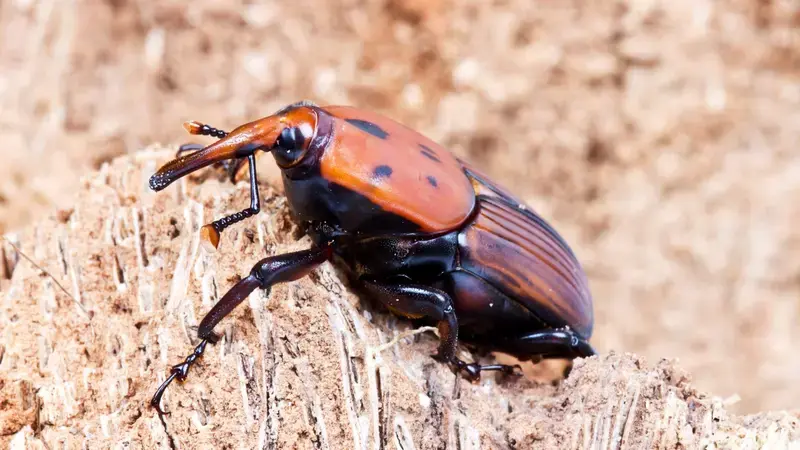Battling the Red Palm Weevil

The red palm weevil can devastate the valuable date palm plantations of the Middle East. Yet, date producers are still hesitant to apply new technologies that can control this invasive pest. A recent ICARDA study reveals factors that hinder pest control adoption.
In the arid regions of the Near East and North Africa (NENA), where palm trees stand as iconic sentinels of agricultural heritage and economic prosperity, a silent menace lurks.
The red palm weevil (RPW), an invasive pest known for its voracious appetite and devastating impact on palm trees, continues to pose a threat despite concerted global efforts to contain it.
Economic implications loom large, with annual losses attributed to RPW in the NENA countries soaring into the millions of dollars. This financial toll encompasses both direct losses in agricultural output and escalating expenditures on pest control measures. Notably, nearly USD 8 million is drained annually solely through the removal of severely infested palm trees—a stark testament to the urgent need for coordinated action.
Beyond Single Solutions
Combating the RPW demands a multifaceted approach that transcends traditional pest control measures. Reliance on any single tactic has proven insufficient. Instead, a cohesive strategy integrating diverse integrated pest management (IPM) approaches emerges as the beacon of hope in this ongoing battle.
Since the 1960s, IPM has advocated for a blend of biological, cultural, mechanical, and chemical controls tailored to local conditions in modern crop protection strategies. However, despite their demonstrated efficacy, the uptake of these practices among farmers in developing regions remains surprisingly low.
Data-Driven Insights
A pioneering study conducted by ICARDA, FAO, KIADPAI, AOAD, and CIHEAM-Bari scientists investigated the adoption rates of RPW IPM practices among Egyptian farmers. The findings showed that overall adoption hovers at a promising 83.85%, but disparities persist among farmer demographics and farm characteristics.
The study identifies two distinct groups among farmers: the "high adopters," comprising 65.9% of the surveyed sample, and the "moderate adopters." Statistical analyses reveal significant variances between these groups, linked to factors such as age, education level, farming experience, and access to governmental support and training initiatives.
Mobilizing for Impact
Central to the study's recommendations is a call for heightened awareness and collaboration among stakeholders. Efforts must intensify across multiple fronts, from grassroots education initiatives targeting farmers and local communities to strategic partnerships involving governmental bodies, research institutions, non-governmental organizations, and the media.
Effective governance, the study contends, hinges on proactive risk perception and robust intervention frameworks. Ex-ante analyses underscore the imperative of preemptive strategies, emphasizing the role of informed decision-making and adaptive management practices in mitigating RPW's spread.
Looking ahead, the pathway to success lies in forging resilient partnerships and leveraging modern communication channels to disseminate knowledge, foster community engagement, and mobilize support for IPM adoption.
References:
"Adoption of Integrated Pest Management Strategies and Ex-ante Assessment of the Red Palm Weevil Control among Egyptian Farmers" – Blessed Tree, Vol No. 16 - Issue No. 02 - February 2024, p: 17-28
"Socioeconomic Impact Assessment of Red Palm Weevil in Egypt and Saudi Arabia: An Ex-ante Evaluation" - Reference: Blessed Tree, Vol No. 16 - Issue No. 02 - February 2024, p: 29-40
ARABIC VERSION: Socioeconomic Impact Assessment of Red Palm Weevil in Egypt and Saudi Arabia
